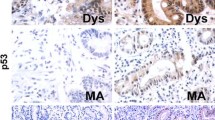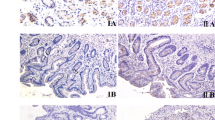Abstract
Objective
To evaluate the relationship between H. pylori infection with cell proliferation, apoptosis and PGE2 levels.
Methods
A population-based study was conducted in Linqu, a high-risk area of gastric cancer in China. A total of 1523 subjects, aged 35–64, participating in a gastric cancer screening survey were investigated. H. pylori status were determined by 13C-urea breath test, expressions of Ki-67 were assessed by immunohistochemistry, apoptotic cells were detected by terminal deoxynucleotide transferase mediated dUTP nick end-labeling (TUNEL) method, and PGE2 levels were measured by enzyme immunoassay.
Results
H. pylori infection was positively associated with cell proliferation activity. The mean and median percentage of Ki-67 labeling index (LI) in subjects with H. pylori positive were 14.1±10.3 and 12.0, significantly higher than those with H. pylori negative (\(\overline x \)±s: 8.4±7.0; median: 5.8; P<0.0001). Moreover, the prevalence rates of H. pylori infection showed a tendency to increase according to severity score of cell apoptosis (Ptrend <0.0001), from score 0 to 3, the percentage of H. pylori positivity increased from 67.5% to 96.7%. Furthermore, The mean and median of PGE2 concentration were 628.84±726.40 pg/mL and 411.33 pg/mL among subjects with H. pylori positive compared with 658.19±575.91pg/mL and 455.97 pg/mL among those with H. pylori negative (P=0.209).
Conclusion
H. pylori infection was positively associated with increased cell proliferation and apoptosis activity, suggesting that H. pylori infection plays an important role in the gastric epithelial cell malignant transformation.
Similar content being viewed by others
References
Parkin DM, Bray FI, Devesa SS. Cancer burden in the year 2000. The global picture[J]. Eur J Cancer 2001; 37: S4–66.
Li LD, Lu FZ, Zhang SW, et al. Cancer mortality trends in China, 1973–1992[J]. Chin J Oncol 1997; 19: 3–9
You WC, Blot WJ, Li JY, et al. Precancerous gastric lesions in a population at high risk of stomach cancer[J]. Cancer Res 1993; 53:1317–1321.
You WC, Li JY, Blot WJ, et al. Evolution of precancerous lesions in a rural Chinese population at high risk of gastric cancer[J]. Int J Cancer 1999; 83: 615–619.
You WC, Zhang L, Gail MH, et al. Gastric dysplasia and gastric cancer: Helicobacter pylori, serum vitamin C, and other risk factors[J]. J Natl Cancer Inst 2000; 92:1607–12.
Zhang L, Blot WJ, You WC, et al. Helicobacter pylori antibodies in relation to precancerous gastric lesions in a high-risk Chinese population[J]. Cancer Epidemiol Biomarkers Prev 1996; 5:627–630.
You WC, Brown LM, Zhang L, et al. Randomized double-blind factorial trial of three treatments to reduce the prevalence of precancerous gastric lesions[J]. J Natl Cancer Inst 2006; 98: 973–983.
Konturek PC, Kania J, Konturek JW, et al. H. pylori infection, atrophic gastritis, cytokines, gastrin, COX-2, PPAR gamma and impaired apoptosis in gastric carcinogenesis[J]. Med Sci Monit 2003; 9: SR53–66.
Konturek PC, Hartwich A, Zuchowicz M, et al. Helicobacter pylori, gastrin and cyclooxygenases in gastric cancer. J Physiol Pharmacol 2000; 51, 737–749.
Saukkonen K, Rintahaka J, Sivula A, et al. Cyclooxygenase-2 and gastric carcinogenesis. APMIS 2003; 111:915–925.
Lynch DAF, Mapstone NP, Clarke AMT, et al. Cell proloferation in Helicobacter pylori associated gastritis and the effect of eradication therapy[J]. Gut 1995; 36: 346–350.
Brenes F, Ruiz B, Correa P, et al. Helicobacter pylori causes hyper proliferation of the gastric epithelium: Pre-and post-eradication indices of proliferating cell nuclear antigen[J]. Am J Gastroenterol 1993; 88: 1870–1875.
Al-Marhoon MS, Nunn S, Soames RW. cagA+ Helicobacter pylori induces greater levels of prostaglandin E2 than cagA-strains[J]. Prostaglandins Other Lipid Mediat 2004;73:181–189
Dixon MF, Genta RM, Yardley JH, et al. Classification and grading of gastritis. The updated Sydney System[J]. International Workshop on the Histopathology of Gastritis, Houston 1994. Am J Surg Pathol 1996; 20:1161–1181.
Rugge M, Correa P, Dixon MF, et al. Gastric dysplasia: the Padova international classification[J]. Am J Surg Pathol 2000; 24:167–176.
Zhang L, Ma J, Pan K, et al. Efficacy of cranberry juice on Helicobacter pylori infection: a double-blind, randomized placebo-controlled trial[J]. Helicobacter 2005; 10:139–145.
Correa P, Miller MJ. Carcinogenesis, apoptosis and cell proliferation[J]. Br Med Bull 1998; 54:151–62.
Britio M, Filipe MI, Morris RW. Cell proliferation study on gastric carcinoma and non-involved gastric mucosa using a bromo deoxyuridine (BrU) labeling technique[J]. Eur J Cancer Prev 1992; 1:429–35.
Correa P. Helicobacter pylori and gastric cancer: state of the art[J]. Cancer Epidemiol Biomarkers Prev 1996; 5: 477–481.
Wagner S, Beil W, Westermann J, et al. Regulation of gastric epithelial cell growth by Helicobacter pylori: Evidence for major role of apoptosis[J]. Gastroenterology 1997; 113:1836–1844.
Wambura C, Aoyama N, Shirasaka D, et al. Effect of Helicobacter pylori-induced Cyclooxygenase-2 on gastric epithelial cell kinetics: implication for gastric carcinogenesis[J]. Helicobacter 2002; 7:129–138.
Moss SF. Cellular markers in the gastric precancerous process[J]. Aliment Pharmacol Ther 1998; 12: 91–109.
Scotiniotis IA, Rokkas T, Furth EE, et al. Altered gastric epithelial cell kinetic in Helicobacter pylori-associated intestinal metaplasia: Implication for gastric carcinogenesis[J]. Int J Cancer 2000; 85:192–200.
Peek Jr RM, Wirth H, Moss SF, et al. Helicobacter pylori alters gastric epithelial cell cycle events and gastrin secretion in Mongolian gerbils[J]. Gastroenterology 2000; 118: 48–59.
Sung JJ, Leung WK, Go MY, et al. Cyclooxygenase-2 expression in Helicobacter pylori-associated premalignant and malignant gastric lesions[J]. Am J Pathol 2000; 157: 729–35.
Sun JH, Das KK, Amenta PS, et al. Preferential expression of cyclooxygenase-2 in colonic-phenotype of gastric intestinal metaplasia: association with Helicobacter pylori and gastric carcinoma[J]. J Clin Gastroenterol 2006; 40:122–128.
Author information
Authors and Affiliations
Corresponding author
Additional information
This work was supported by the Grants from National “211” Project in Peking University (Grant 529 and 533), Beijing Municipal Commission of Science and Technology Grant (H0209-20030130).
Rights and permissions
About this article
Cite this article
Pan, Kf., Zhang, Y., Zhang, L. et al. Helicobacter pylori infection in association with cell proliferation, apoptosis and prostaglandin E2 levels. Chin. J. Cancer Res. 19, 249–254 (2007). https://doi.org/10.1007/s11670-007-0249-4
Received:
Accepted:
Issue Date:
DOI: https://doi.org/10.1007/s11670-007-0249-4




